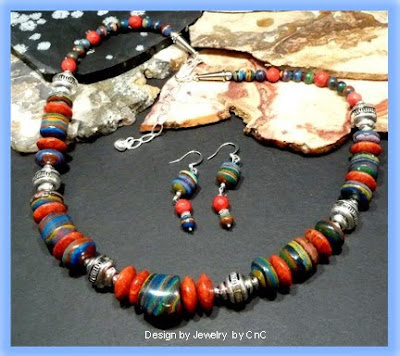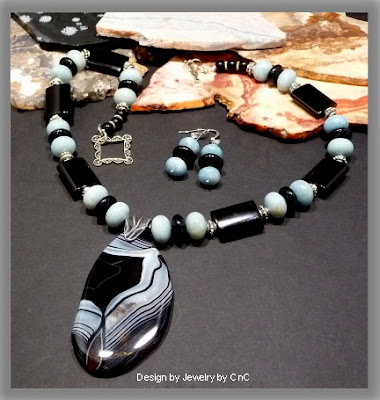 When Calsilica, sometimes spelled calcilica, first appeared on the fashion jewelry circuit, it started a controversy and has and continues to create quite a stir because of its beauty and has generated a fair bit of controversy and speculation over it's true origin – particularly whether it is a naturally-occurring stone, or a man-made material. After its initial appearance, the most persistent claim has been that Calsilica is found at a mine in the Mexican state of Chihuahua, in the veins or seams of the volcanic Rhyolite that is mined at this location. This speculation of being man-made is continuing because geologists have been denied access to the mine, supposedly to protect the resource from over-exploitation. In the last few years, focus has changed and now is centered on an alleged deposit of Rainbow Calsilica in China.
When Calsilica, sometimes spelled calcilica, first appeared on the fashion jewelry circuit, it started a controversy and has and continues to create quite a stir because of its beauty and has generated a fair bit of controversy and speculation over it's true origin – particularly whether it is a naturally-occurring stone, or a man-made material. After its initial appearance, the most persistent claim has been that Calsilica is found at a mine in the Mexican state of Chihuahua, in the veins or seams of the volcanic Rhyolite that is mined at this location. This speculation of being man-made is continuing because geologists have been denied access to the mine, supposedly to protect the resource from over-exploitation. In the last few years, focus has changed and now is centered on an alleged deposit of Rainbow Calsilica in China.  Many claim Calsilica, also known more commonly as Rainbow Calsilica, is a synthetic stone that is manufactured from a mixture of Calcite, plastic resins and artificial coloring pigments. The different colored bands through Rainbow Calsilica are powdered carbonate rock artificially colored and then stabilized with plastic resin. The bands of color can come in any order and in any color. Despite possibly being a synthetic stone, Rainbow Calsilica has been increasing in demand for jewelry, especially high end items. Natural or man-made or man-enhanced, Rainbow Calsilica is one of those stones that always draws attention.
Many claim Calsilica, also known more commonly as Rainbow Calsilica, is a synthetic stone that is manufactured from a mixture of Calcite, plastic resins and artificial coloring pigments. The different colored bands through Rainbow Calsilica are powdered carbonate rock artificially colored and then stabilized with plastic resin. The bands of color can come in any order and in any color. Despite possibly being a synthetic stone, Rainbow Calsilica has been increasing in demand for jewelry, especially high end items. Natural or man-made or man-enhanced, Rainbow Calsilica is one of those stones that always draws attention.. Others claim that Calsilica, or "Rainbow Calsilica", is a naturally occurring material. However, all seem to agree that Calsilica, just like Turquoise, is most of the time stabilized to keep it from flaking, and protect the colors when being worn as jewelry.
Others claim that Calsilica, or "Rainbow Calsilica", is a naturally occurring material. However, all seem to agree that Calsilica, just like Turquoise, is most of the time stabilized to keep it from flaking, and protect the colors when being worn as jewelry.
.
Calsilica jewelry can be very dynamic. As seen to the left, in this piece designed by Gayle, the Rainbow Calsilica combined with Sponge Coral and Silver beads is a stand-out. So where do we stand today? Based on all available information, it appears that Calsilica is essentially an agglomeration of several natural and man-made materials, Calcite being the predominent mineral and held together by a paraffin-like binding agent. The original contention that Calsilica is a form of microcrystalline Calcite may be accurate, but binding agents are most likely man-made. Until the "mine owners" in Chihuahua provide greater access to the site, it would be wise to assume that Calsilica has at least been mofdified by man.
.
 Calsilica specimens can be quite beautiful and colorful, and as such, can be used too make earrings, pendants, beads, rings, and other items. As seen to the right, a necklace of graduated Calsilica beads put together by Jay King, becomes quite dramatic on its own. While the purists amongst us may be disappointed that Calsilica is perhaps man-made or man-modified, Calsilica continues to capture the imagination of jewelry designer as well as jewelry wearers alike. It is really any different that the common practice of stabilizing Turquoise? The key in the future of Calsilica may be seeing the mine and determining if colorization in addition to the stabilizing, is being done on the natural stone.
Calsilica specimens can be quite beautiful and colorful, and as such, can be used too make earrings, pendants, beads, rings, and other items. As seen to the right, a necklace of graduated Calsilica beads put together by Jay King, becomes quite dramatic on its own. While the purists amongst us may be disappointed that Calsilica is perhaps man-made or man-modified, Calsilica continues to capture the imagination of jewelry designer as well as jewelry wearers alike. It is really any different that the common practice of stabilizing Turquoise? The key in the future of Calsilica may be seeing the mine and determining if colorization in addition to the stabilizing, is being done on the natural stone.
 Calsilica specimens can be quite beautiful and colorful, and as such, can be used too make earrings, pendants, beads, rings, and other items. As seen to the right, a necklace of graduated Calsilica beads put together by Jay King, becomes quite dramatic on its own. While the purists amongst us may be disappointed that Calsilica is perhaps man-made or man-modified, Calsilica continues to capture the imagination of jewelry designer as well as jewelry wearers alike. It is really any different that the common practice of stabilizing Turquoise? The key in the future of Calsilica may be seeing the mine and determining if colorization in addition to the stabilizing, is being done on the natural stone.
Calsilica specimens can be quite beautiful and colorful, and as such, can be used too make earrings, pendants, beads, rings, and other items. As seen to the right, a necklace of graduated Calsilica beads put together by Jay King, becomes quite dramatic on its own. While the purists amongst us may be disappointed that Calsilica is perhaps man-made or man-modified, Calsilica continues to capture the imagination of jewelry designer as well as jewelry wearers alike. It is really any different that the common practice of stabilizing Turquoise? The key in the future of Calsilica may be seeing the mine and determining if colorization in addition to the stabilizing, is being done on the natural stone..
There are other varieties of Calsilica on the market also. Below are a couple of other color combinations, both also out of Mexico. The second picture below is a new find a couple years ago from Sonora, Mexico area and is called Sonoran Sunrise.
















